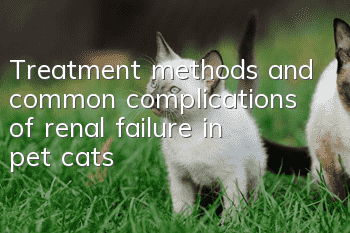Treatment methods and common complications of renal failure in pet cats

Renal failure is a very common medical disease in pets. Because there are many causes of renal failure, there are many mistakes in diagnosis and treatment. Renal failure has many complications, which are related to almost all major systems in the body. If these questions are not clarified, it will be difficult for us to treat animals with renal failure, and the probability of the pet’s recovery will also be greatly reduced.
1. To identify acute and chronic renal failure, we can start from the following points:
Look at whether the body muscles of the sick animals are plump. Generally, animals with chronic renal failure become emaciated and their back muscles atrophy due to a period of uremia damage and consumption.
Questionnaire: The onset of acute renal failure is more rapid, with more vomiting symptoms. When urea nitrogen is high, although ammonia can be smelled in the mouth, the incidence of secondary oral ulcers is low.
Imaging examination: X-ray examination shows that the size of the kidney usually increases or remains unchanged in acute renal failure, but the opposite is true in chronic renal failure; B-ultrasound examination shows that in acute renal failure, the changes in the renal cortex and medulla are greater than those in chronic renal failure. Much smaller.
Routine blood examination shows anemia in some cases of chronic renal failure, and rare cases of acute renal failure.
Electrolyte examination shows that hypokalemia is common in the polyuric phase of chronic renal failure, while hyperkalemia is common in the oliguric phase of acute renal failure.
2. Complications of renal failure:
1. Nervous system
Elevated BUN/CRE leads to nerve cell degeneration, increases blood pressure, and ultimately causes cerebral edema.
2. Motion system
Mainly bones. Renal failure causes hyperparathyroidism, and stimulation of large amounts of phosphorus ions causes a decrease in blood calcium and impairment of VD utilization and absorption. Caused lesions: osteomalacia, fibrinous osteitis, bone pain, joint pain, etc.
3. Digestive system
The lesions of the digestive system are the most obvious. Urea decomposes to produce blood ammonia, which can irritate the mucous membrane of the digestive tract and cause ulcers and bleeding in the digestive system. Coupled with long-term anorexia, vomiting, and large amounts of gastric acid secretion, it eventually leads to gastric damage.
4. Respiratory system
Urea enters the lungs with blood circulation, causing fibrinous pneumonia, pleurisy, cough, etc. Hyperparathyroidism causes alveolar calcification. Accelerated breathing, excessive breathing, causing acidosis. Heart failure, water retention, and hypoalbuminemia can cause pulmonary edema.
5. Circulatory system
Because acidosis, hypertension, and toxic substances such as uric acid damage the myocardium, it may cause myocardial degeneration, pericardial effusion, and heart failure.
6. Nutritional metabolism
Chronic consumption, decreased blood sugar, and abnormal protein metabolism. Weight loss, dehydration.
7. Cover system
SkinSkin calcification, melanin deposition, skin ecchymosis, and coarse hair are visible.
When diagnosing every case of renal failure, you must remember to do a B-ultrasound examination. Especially the B-ultrasound examination of the kidneys. Look at the shape of the kidney, the thickness of the cortex and medulla, as well as the scales, renal cones, etc., and whether there are abnormal structures and lesions.
3. Treatment methods
When the body’s blood pressure drops and cardiac output is insufficient, animals are in danger of shock and death at any time. In this case, inotropic drugs such as digoxin and pimobendan must be used promptly and decisively. Dopamine, ligustrazine hydrochloride, 654-2, etc. can be used to raise blood pressure. These drugs can effectively improve renal perfusion.
For acute renal failure, after treatment, renal function can remain above 25%, and lifelong treatment may not be needed. If it is <25%, it will turn into chronic renal failure, and you may face long-term, lifelong medication.
A reasonable diet, meticulous care by the owner, and complete systematic follow-up treatment are all necessary factors for the continued survival of kidney failure cases.
- Why do cats’ anal glands smell so bad?
- After changing the cat litter, the cat stopped pooping
- How can a cat tell she's pregnant?
- Can cats eat pork and beef?
- Can pet cats eat fatty beef?
- Cat vomited half-digested cat food
- What should you do if your cat is sick and refuses to take medicine? Teach you practical techniques for feeding cats medicine!
- How to train a cat not to scratch furniture? Cat training!
- When choosing cat food, don’t just look at the rankings. The best one is suitable for your cat.
- How much weight can a British Shorthair female cat gain?



